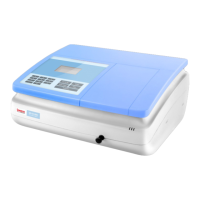
Do you have a question about the Spectrum SP-UV 200 Series and is the answer not in the manual?
| Wavelength Range | 190-1100nm |
|---|---|
| Wavelength Accuracy | ±0.5nm |
| Detector | Silicon Photodiode |
| Stray Light | ≤0.05%T (at 220nm Nal, 340nm NaNO2) |
| Display | LCD |
| Light Source | Deuterium and Tungsten lamps |
| Interface | USB |
| Dimensions | 460mm |
Describes warning and safety labels located on the SP-UV 200 unit.
Covers intended use, local regulations, qualified personnel, and emergency stop procedures.
Warns about electric shocks and UV radiation hazards from the device.
Details precautions against explosion risks, heat accumulation, liquid handling, and corrosion.
Advises on safe handling of lamps to prevent damage and injury from heat or radiation.
Outlines environmental conditions for installation, storage, and transport of the device.
Provides instructions for correctly installing and starting up the SP-UV 200.
Explains how to select the light source switch point between 325nm and 355nm.
Describes how to turn the halogen and deuterium lamps on or off as needed.
Provides step-by-step instructions and safety precautions for replacing the halogen lamp.
Details the procedure and safety warnings for replacing the deuterium lamp.
Details the manual 4-cell changer accessory for 1 cm, 5 cm, 10 cm, 50 cm, and 100 cm cells.
Explains the adjustable cell holder for micro and ultra-micro cells requiring precise alignment.
Describes the special cell holder for round test kit cells with specified dimensions.
Details the automatic 6-cell changer accessory for 10mm path length cells.
Explains how to connect and install a printer to the SP-UV 200.
Lists the primary functions accessible from the main menu, including measurements and settings.
Guides users on how to change the display language of the instrument's interface.
Explains how to turn the tungsten-halogen and deuterium lamps on or off via the software.
Details the procedures for Absorbance, Transmittance, and Concentration measurements.
Covers various methods for calculating sample concentration, including calibration techniques.
Instructions for setting the instrument's internal clock and date.
Explains how to select the correct lamp exchange procedure based on wavelength.